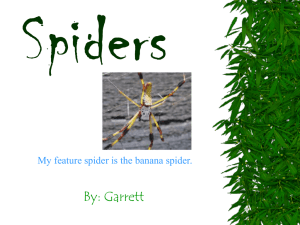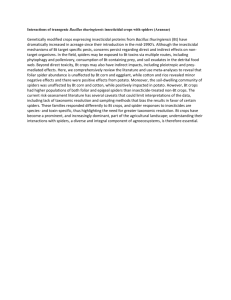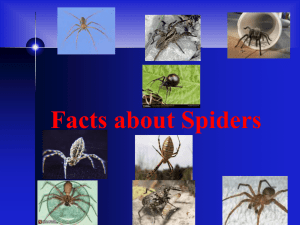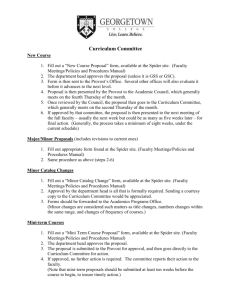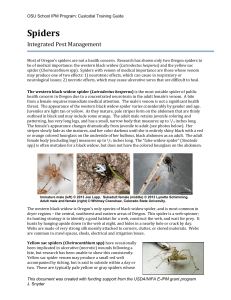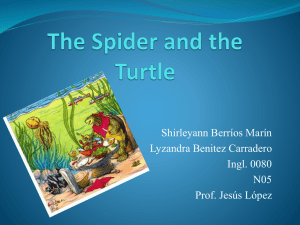File
advertisement
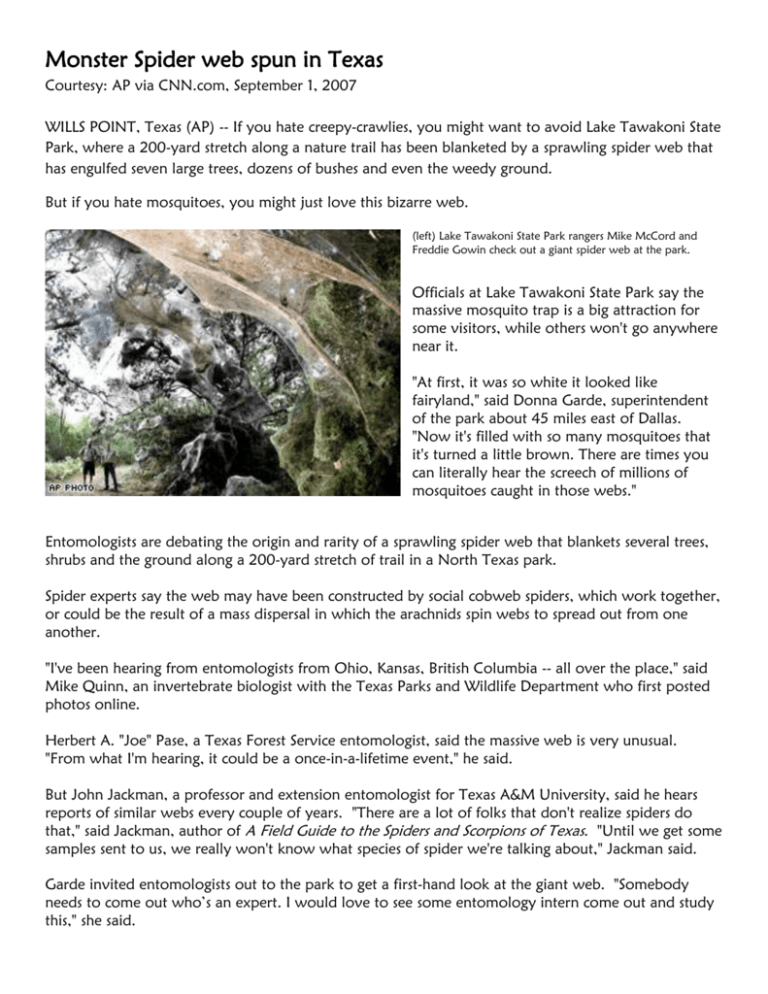
Monster Spider web spun in Texas Courtesy: AP via CNN.com, September 1, 2007 WILLS POINT, Texas (AP) -- If you hate creepy-crawlies, you might want to avoid Lake Tawakoni State Park, where a 200-yard stretch along a nature trail has been blanketed by a sprawling spider web that has engulfed seven large trees, dozens of bushes and even the weedy ground. But if you hate mosquitoes, you might just love this bizarre web. (left) Lake Tawakoni State Park rangers Mike McCord and Freddie Gowin check out a giant spider web at the park. Officials at Lake Tawakoni State Park say the massive mosquito trap is a big attraction for some visitors, while others won't go anywhere near it. "At first, it was so white it looked like fairyland," said Donna Garde, superintendent of the park about 45 miles east of Dallas. "Now it's filled with so many mosquitoes that it's turned a little brown. There are times you can literally hear the screech of millions of mosquitoes caught in those webs." Entomologists are debating the origin and rarity of a sprawling spider web that blankets several trees, shrubs and the ground along a 200-yard stretch of trail in a North Texas park. Spider experts say the web may have been constructed by social cobweb spiders, which work together, or could be the result of a mass dispersal in which the arachnids spin webs to spread out from one another. "I've been hearing from entomologists from Ohio, Kansas, British Columbia -- all over the place," said Mike Quinn, an invertebrate biologist with the Texas Parks and Wildlife Department who first posted photos online. Herbert A. "Joe" Pase, a Texas Forest Service entomologist, said the massive web is very unusual. "From what I'm hearing, it could be a once-in-a-lifetime event," he said. But John Jackman, a professor and extension entomologist for Texas A&M University, said he hears reports of similar webs every couple of years. "There are a lot of folks that don't realize spiders do that," said Jackman, author of A Field Guide to the Spiders and Scorpions of Texas. "Until we get some samples sent to us, we really won't know what species of spider we're talking about," Jackman said. Garde invited entomologists out to the park to get a first-hand look at the giant web. "Somebody needs to come out who’s an expert. I would love to see some entomology intern come out and study this," she said. Thanks to the unusual nature of the Star-Telegram article, the world went crazy with spider mania. Google News reported 290 stories around the world about the web at Lake Tawakoni. The story was reported in Europe, Australia, and even China. Two days later, it was even the lead story in the Nation section of the New York Times and was the #1 emailed story on their web site. Got Arachnophobia? Here's Your Worst Nightmare By GRETEL C. KOVACH Published: August 31, 2007 Most spiders are solitary creatures. So the discovery of a vast web crawling with millions of spiders that is spreading across several acres of a North Texas park is causing a stir among scientists, and park visitors. Sheets of web have encased several mature oak trees and are thick enough in places to block out the sun along a nature trail at Lake Tawakoni State Park, near this town about 50 miles east of Dallas. The gossamer strands, slowly overtaking a lakefront peninsula, emit a fetid odor, perhaps from the dead insects entwined in the silk. The web whines with the sound of countless mosquitoes and flies trapped in its folds. Allen Dean, a spider expert at Texas A&M University, has seen a lot of webs, but even he described this one as ''rather spooky, kind of like Halloween.'' Mr. Dean and several other scientists said they had never seen a web of this size outside of the tropics, where the relatively few species of ''social'' spiders that build communal webs are most active. Norman Horner, emeritus professor of biology at Midwestern State University in Wichita Falls, Tex., was one of a number of spider experts to whom a Texas Parks and Wildlife Department biologist sent online photos of the web. ''It is amazing, absolutely amazing,'' said Dr. Horner, who at first thought it an e-mail hoax. The web may be a combined effort of social cobweb spiders. But their large communal webs generally take years to build, experts say, and this web was formed in just a few months. Or it could be a striking example of what is known as ballooning, in which lightweight spiders throw out silk filaments to ride the air currents. Five years ago, in just that way, a mass dispersal of millions of tiny spiders covered 60 acres of clover field in British Columbia with thick webbing. Mike Quinn, the state biologist who distributed the online photos, and who runs a Web site about Texas invertebrates, plans to drive to the park from Central Texas on Friday in an effort to get some answers by collecting samples. Record-breaking rains that flooded Texas earlier this summer inspired outbreaks of crickets and ''webworms,'' the caterpillar larvae of the white moth. Mr. Quinn said the rains might have something to do with the web, too. ''You'd have to get a lot of spiders together and feed them a whole lot of food to make a web that big,'' he said. Whatever caused the vast web, the sight of it has inspired both awe and revulsion. ''It's beautiful,'' said the park's superintendent, Donna Garde. Freddie Gowin disagrees. It was Mr. Gowin, a maintenance worker at the park, who discovered the web this month when, taking advantage of some of the first dry weather, he mowed the area around the nature trail. ''I don't think there's anything pretty about it,'' he said, though ''it's certainly unusual.'' When Mr. Gowin drives the power mower through the area, webbing wraps across his bare face, causing him to slap at spiders, real or imagined, crawling on his skin. Photos Video http://texasento.net/Social_Spider.htm http://www.youtube.com/watch?v=haf3X5i7XEI Blog/Narrative http://spiderjoe.com/giant-webs-2007 Return to Texas Entomology - Compiled by Mike Quinn Giant Spider Web in an East Texas State Park - 2007 Guatemalan Long-jawed Spider Tetragnatha guatemalensis O. P.-Cambridge Family Tetragnathidae - Long-jawed Orb Weavers Spider Joe also maintains a photo- and information-rich website concerning this phenomenon Photo Credit: Donna Garde, Texas Parks & Wildlife Lake Tawakoni State Park, n. Wills Point, Hunt Co., Texas August 15, 2007 (Donna Garde) [pronounced like "guard"] This web was first found by park staff on August 6, 2007, after an approximate two week absence of walking the trail. This web and two other smaller versions are on the park's large northeastern peninsula jutting out into the lake. Google map of park Almost all tetragnathids were making loose, messy, atypical webs like this. Lake Tawakoni State Park, n. Wills Point, Hunt Co., Texas August 31, 2007 (Mike Quinn) Range: Nova Scotia, Minnesota, Kansas, New Mexico, southern California, south to Panama, Cuba, Jamaica. (Levi 1981) Size: Total length of females: 5.4 to 11.5 mm (Levi 1981) Total length of males: 5.2 to 10.2 mm Habitat: On vegetation near water (Levi 1981) Note: One of the most common Long-jawed spiders in Texas is Tetragnatha laboriosa whose "reproductive capabilities and ability to disperse by ballooning are remarkable." (Jackman 1997) Remarkable indeed... Similar Species: There are currently 989 species of spiders (in 52 families) known from Texas (Dean, 2007). There are 15 species (in six genera) in the family Tetragnathidae in Texas (Dean, 2007). There are 10 species in the genus Tetragnatha in Texas (Dean, 2007). Tetragnatha caudata Emerton, 1884 Tetragnatha elongata Walckenaer, 1842 Tetragnatha guatemalensis O. P.-Cambridge, 1889 Tetragnatha laboriosa Hentz, 1850 Tetragnatha nitens (Audouin, 1826) Tetragnatha pallescens F. O. P.-Cambridge, 1903 Tetragnatha straminea Emerton, 1884 Tetragnatha vermiformis Emerton, 1884 Tetragnatha versicolor Walckenaer, 1842 Tetragnatha viridis Walckenaer, 1842 Weblinks: Tetragnatha guatemalensis O. P.-Cambridge, 1889 - The Nearctic Spider Database Photos: Tetragnatha guatemalensis - (large) - Jeff Hollenbeck Tetragnathid Jaw Closeup - Tetragnatha - BugGuide.Net Tetragnatha with Prey - BugGuide.Net Typical Tetragnatha orb web full of midges - BugGuide.Net Tetragnatha releasing silk from two spinnerets - BugGuide.Net Tetragnatha in typical resting posture - BugGuide.Net Tetragnatha nitens - Marjorie Moody Tetragnatha with captured male Dusky Dancer (Argia translata) - Greg Lasley Tetragnatha versicolor - mating - American Museum of Natural History Tetragnatha line drawing showing jaws and eye pattern David Tidgwell sent this link to photos he shot of a similar event he photographed in Anthony C Beilenson Park, Encino, (Los Angeles), California in February 2005. They completely enshrouded at least 200m of trees along a stream. Approximately eight Tetragnathids can be seen in this enlarged image. Etymology: Tetragnatha guatemalensis O. P.-Cambridge tetr, -a (G). Four gnath, -o, =us (G). The Jaw Guatemala - Country were spider was first discovered Biography: Octavius Pickard-Cambridge (1828 - 1917) was an English clergyman and zoologist Wikipedia Chronology of Discovery August 06, 2007 - Web found by Texas Parks & Wildlife employee Freddie Gowin while mowing the trails at Lake Tawakoni State Park. August 15, 2007 - Donna Garde, Lake Tawakoni State Park Superintendent, took the following photo. August 24, 2007 - Donna Garde's photo was sent to Mike Quinn, invertebrate biologist, Texas Parks & Wildlife and to a number of arachnologists. Initial speculation was that the massive web belonged to a social spider, probably Anelosimus studiosus, family Theridiidae. The email with with photos of the Lake Tawakoni web also included a photo of two Long-jawed Orb Weaver spiders, family Tetragnathidae, but these were considered to be incidental or minor contributors to the massive web as tetragnathids normally make orb webs which were not apparent in the photos of the giant web. August 28, 2007 - Robb Bennett, Ph.D., Editor-in-Chief, The Canadian Entomologist (pers. comm. Aug. 28, 2007) "...it would not surprise me if this is the result of another mass dispersal event (rather than the result of theridiid communal activity). The web page states that the web only appeared recently - in my experience communal spider webs take a considerable time to achieve this sort of size. I have seen dictynid and theridiid communal webs achieving this magnitude (and greater) and morphology but those webs were all long established. Araneid communal webs can be huge, too, but of course of different morphology and, similarly, take a long time to achieve great size. August 28, 2007 - Dr. Ingi Agnarsson, University of Akron, OH (pers. comm., Aug. 28, 2007) "I agree. I am excited about the possibility of this being a social spider, but it doesn't make any sense as A. studiosus and if the web is recent it is much more likely to be the remains of an erigonine dispersal event. Will be fun to find out though... August 29, 2007 - Bill Hanna at the Fort Worth Star Telegram broke the story Per photos, the dominant spider is a member of the family Tetragnathidae (Long-jawed Orb Weavers) August 31, 2007 - Joe Lapp (a.k.a. Spider Joe) and Mike Quinn visited Lake Tawakoni State Park. We shot some video and stills. I collected a large sample of spiders with a beat sheet (example). "There were many other spiders in the webs. In order of how common they appeared to be, most common first, I saw Tetragnathids, Salticids, Theridiids (Argyrodes sp.), Araneids, Agelenids, and Lycosids. We even had one Mimetid (pirate/cannibal spider). (Joe Lapp, Tawakoni visit report posted to TX-Ento, 2 Sep 2007) August 31, 2007 - David Tidgwell sent this link to photos he shot of a similar event in Anthony C Beilenson Park, Encino, (Los Angeles), California in February 2005. They completely enshrouded at least 200m of trees along a stream. Approximately eight Tetragnathids can be seen in this enlarged image. September 1, 2007 - Mike Quinn drove the spiders he collected on Aug. 31 to Texas A&M University, College Station and turned them over to Allen Dean, and John Jackman for identification. The specimens will be curated in the Texas A&M University Insect Collection. September 2, 2007 - Allen Dean reported (pers. comm., Sept. 2007) that he identified 11 spider families from the sample I collected Aug. 31. The most common families from the sample were Tetragnathidae, Salticidae, Theridiidae and Araneidae with relatively few representatives from the remaining eight spider families. There were no Linyphiidae spiders, nor any Anelosimus social spiders. The most abundant spider was Tetragnatha guatemalensis O. P.-Cambridge. A report will be issued shortly by John Jackman and Allen Dean. Draft spider list. September 2, 2007 - David Richman, Professor and Curator of the Arthropod Museum, Dept. of Entomology, New Mexico State University, Las Cruces, NM, posted the following reply on Sept 2 to Joe Lapp's Aug. 31 report. "I have observed a similar aggregation of Tetragnatha at Newnans Lake in Alachua County, Florida. Perhaps not as big, but certainly impressive, the "web" consisted of thousands of Tetragnatha webs literally stacked one upon the other. ... The situation was [near(?)] a huge midge (Chironomidae) emergence. [Links added by MAQ] September 1-3, 2007 - 3,000 visitors came to the Lake Tawakoni State Park specifically to see the spider web over Labor Day Weekend! September 4, 2007 - Norman Horner, Midwestern State University, Wichita Falls, TX (pers. comm., Sept. 2007): "So far, we have been informed about webs of this nature occurring in Florida, California, Canada, Italy, Ohio and now Texas. In all cases they appear to have been produced by tetragnathids (longjawed orb weavers), but have other spiders associated with them. September 6, 2007 - Hank Guarisco, Adjunct Curator of Arachnids, Sternberg Museum of Natural History, Fort Hays State University, Hays, Kansas reported the following: "I have been here for several days and am making some very interesting observations. ... The [Tetragnatha] females are actively building webs at night, and the males wander around. They are often only 1-3 inches apart. ... I recognized Neoscona crucifera (only a few), Larinioides cornutus, Phidippus audax, Agelenopsis and probably Barronopsis texana, Argyrodes elevatus and their distinctive egg sacs, Paraphidippus aurantius, Eris militaris, one Argiope aurantia. There are many Larinioides that come out at night and build webs over everything. ... Deep inside, there is Anelosimus studiosus, but not as obvious or common as I originally suspected. September 7, 2007 A Preliminary List of the Spiders Collected from a Giant Web at Lake Tawakoni, Texas by John A. Jackman, Allen Dean, Mike Quinn Results "A summary of the spider taxa and numbers collected is provided in Table 1. Samples contained 250 specimens in 12 families. The samples contained at least 16 identified genera. "The spiders sampled included 151 Tetragnathidae, 46 Salticidae, and 19 Araneidae. These three families represented 60.0 %, 18.4 %, and 7.6 % of the spiders in the samples respectively. These three spider families accounted for 86 % of the spiders collected. September 22, 2007 - Joe Lapp, Lake Tawakoni 9/19 trip report I visited Lake Tawakoni again, this time better armed with still cameras and a video camera. I arrived Wednesday 9/19 at about noon, left about 30 hours later, and spent about half of that time observing the spiders. I don't know what the spiders are doing from midnight to 6am, but I got a sense of things for the remaining hours. (Full report) Addendum: During the day, many male and female Tetragnathids -- but mostly females -- positioned themselves in orb webs made by the Araneids the night before. October 1, 2007 - A second large spider web was reported at Wind Point Park, located on the north side of Lake Tawakoni by Pam Rousseau, a park employee. The web was first noticed about three weeks ago. It's now covering parts of 10 trees and is still growing. Photos sent to Mike Quinn show a very fresh web engulfing multiple trees. Joe Lapp and Hank Guarisco were conducting a second survey of the first web at Lake Tawakoni State Park when they received work of the second web at Wind Point Park. They drove to the new web and reported (pers. comm., Oct. 2007) finding mostly Long-jawed Spiders, but also large numbers of Social Spiders, Anelosimus studiosus. (ID yet to be confirmed.) October 3, 2007 - Two more sizable webs were located at Wind Point Park near the lake. October 4, 2007 - Joe Lapp confirmed that there is a large tetragnathid dominated spider web on Starnes Island in Lake Travis! October 17, 2007 - Jim Swift of KXAN.com aired a piece on Joe Lapp and the spider web on Starnes Island. October 18, 2007 - Large spider web reported at Arkansas Bend Park. Google map to park southeast of Lago Vista, TX. LCRA calls this 323-acre park lies on the north shore of Lake Travis "one of the most isolated and untouched parks in Travis County". October 28, 2007 - Joe Lapp was interviewed by Suzanne Dragan, Host "Animal Talk" 1450Am WCTC, New Brunswick, NJ Joe Lapp continues to post regular updates on all the large lake-side spider webs in Texas January 2008 - Based on reports noted above, Mike Quinn constructed the following Google map: Giant Spider Webs of Texas and Beyond Contacts The following people (in alphabetical order) are well versed in the giant spider web at Lake Tawakoni: Allen Dean, Research Assistant, Department of Entomology, Texas A&M University, College Station, TX Donna Garde, Park Superintendent, Texas Parks & Wildlife, Lake Tawakoni State Park, Wills Point, TX Hank Guarisco, Adjunct Curator of Arachnids, Sternberg Museum of Natural History, Fort Hays State University, Hays, Kansas Norman Horner, Biology Professor and Spider Authority, Midwestern State University, Wichita Falls, TX John A. Jackman, Professor and Extension Entomology Specialist, Texas A&M University, College Station, TX Joe Lapp, Spider Enthusiast, Austin, TX - See his journal documenting all the large lake-side spider webs of Texas Mike Quinn, Invertebrate Biologist, Texas Parks & Wildlife, Austin, TX Media Reports Print Bill broke the story.... Star-Telegram - Fort Worth Giant web creates bug buzz August 29, 2007 By BILL HANNA ------------------------------------Star-Telegram - Fort Worth Colossal spider web gets worldwide attention August 31, 2007 By BILL HANNA ------------------------------------New York Times Got Arachnophobia? Here’s Your Worst Nightmare August 31, 2007 By GRETEL C. KOVACH WILLS POINT, Tex., Aug. 29 — Most spiders are solitary creatures. So the discovery of a vast web crawling with millions of spiders that is spreading across several acres of a North Texas park is causing a stir among scientists, and park visitors. Sheets of web have encased several mature oak trees and are thick enough in places to block out the sun along a nature trail at Lake Tawakoni State Park, near this town about 50 miles east of Dallas. The gossamer strands, slowly overtaking a lakefront peninsula, emit a fetid odor, perhaps from the dead insects entwined in the silk. The web whines with the sound of countless mosquitoes and flies trapped in its folds. (This story was No.1 on the list of most emailed stories from that day's edition of the New York Times, and it was the lead story in the Nation section of the print edition...) -----------------------------------Reuters Texas spiders' monstrous webs baffle scientists Sept 1, 2007 By ED STODDARD LAKE TAWAKONI STATE PARK, Texas - Texans like to say everything in their state is bigger. They can now add spider webs to that list. [This report was picked up by Scientific American.com] -----------------------------------The Dallas Morning News Experts: Mass web made by spiders living in harmony Sept. 11, 2007 By JAMES HOHMANN Hohmann (pers. comm., Sept 11, 2007): The spider web follow up that ran today is the most visited story on the web site today, again. People at the office are even talking about it around the water cooler, still weeks later. -----------------------------------Star-Telegram - Fort Worth Thousands of spiders worked together to build huge web Sept. 12, 2007 By ANNA M. TINSLEY -----------------------------------ScienceDaily Enormous Spider Web Found In Texas Sep. 13, 2007 An arachnaphobe’s worst nightmare, the gauzy, insect-laden web drew more than 3,300 curious visitors over the three-day holiday to this 376-acre park on the shore of Lake Tawakoni, 50 miles east of Dallas. On Labor Day, the park recorded 1,275 people visiting just to see the web. -----------------------------------Star-Telegram - Fort Worth Another giant spider web discovered Oct. 02, 2007 By Bill Hanna Just as a gigantic web that drew worldwide attention wanes, another one is forming on the opposite side of Lake Tawakoni. -----------------------------------Star-Telegram - Fort Worth The 10 most-read stories of 2007 Dec. 31, 2007 7. Giant web creates bug buzz Aug. 30 - Bill Hanna - Star-Telegram staff writer Photographs STAR-TELEGRAM / TOM PENNINGTON See a close-up view of the spider web Very High Resolution Lake Tawakoni State Park rangers Mike McCord, left, and Freddie Gowin monitor the growth of a giant communal spider web at the park Tuesday. The web, rare for Texas, has formed over the past several weeks. (This photograph has since been reproduced many times around the world. Note: shot with a wide angle lens so perspective is distorted.) -----------------------------------NBC Channel 5 - Dallas / Fort Worth Sprawling Spider Web Engulfs North Texas Trail August 30, 2007 -----------------------------------Huge Spider Web Attracting the Curious in Texas By Mike Chang on Sept 2, 2007 in ScienceMode (False color photo of web) -----------------------------------TPWD Images: Downloads for News Media Tawakoni Spiders Radio: Health & Science NPR : Even Spiders Know Everything's Bigger in Texas (04:53) All Things Considered, August 31, 2007 · Lake Tawakoni State Park in Texas has some new tenants: spiders – lots of spiders. And they've spun a giant communal web. Several hundred yards along a nature trail have been taken over by the elaborate arachnid construction. Webs stretch from tree to tree — and down to the ground. Donna Garde, the superintendent of the park, talks with Melissa Block. Videos: YouTube Video Huge Spider Web Spun in Texas check this video out. a massive colony that consisted of thousands of spiders got together and spun a monster web overnight that is as long as two football fields. watch this video and hear what the eyewitnesses have to say in this tiny town called wills point, 40 miles east of dallas. (Interview of Texas Parks & Wildlife park staff Freddie Gowin and Donna Garde, plus park visitors.) ------------------------------------Star-Telegram - Fort Worth A Tangled Web: Massive Spider Web At Lake Tawakoni State Park A massive spider web has spread over a large area at Lake Tawakoni State Park, drawing visitors, and international attention, to the area. (August 31, 2007) Video and editing by Darrell Byers (Interview of Mike Quinn, invertebrate biologist, TPW) ------------------------------------KLTV 7 Tyler-Longview-Jacksonville Giant Spider Web Spins The Heads Of Experts It's like the movie Arachnophobia came to life, and it's right here in East Texas. (Interview of TPW park staff Freddie Gowin and Donna Garde, plus park visitors.) ------------------------------------FOXNews.com Millions of spiders spin web spanning 200 yards in Texas (Interviews of Donna Garde, Mike Quinn) ------------------------------------CNN affiliate WFAA Monster spider web spun in Texas August 31, 2007 (Park Superintendent Donna Garde discusses web in background) ------------------------------------NBC5i.com Reveals 2007's Most Popular Stories December 31, 2007 FORT WORTH, Texas -- NBC5i.com covered hundreds of memorable stories in 2007, but five stories -which range from hard news to entertainment, with a dash of weird news in between -- clicked the most with viewers. A massive spider web captured so many viewer clicks it comes in as NBC5i.com's No. 5 most popular story of 2007. The two giant spider webs that formed at Lake Tawakoni drew worldwide attention in October. The spider webs covered hundreds of feet and were the collaboration of possibly thousands of spiders, experts said. Images | Video Web: Wikinews, the free news source you can write! 200 yard spider web found in Lake Tawakoni State Park, East Texas September 1, 2007 -----------------------------------Boing Boing Giant web woven by a variety of spider families Posted by David Pescovitz, September 13, 2007 Best comment posted by Stacyj , September 13, 2007 8:29 AM: Man, I would -love- to see that (and wow, I had no idea that there were such things as pirate spidarrrrrs! The universe gets more delightful by the day!) Satire: Giant spider web threatens Lake Tawakoni visitors From the "OMG!" files. By John P. Meyer September 2, 2007 Disconsolate over the discovery of his hidden lair, Spider-man can only sit and brood. (This was the fav of the park staff) ------------------------------------Monster web spun around Predator Chapel Ranch in Crawford, Texas The Spoof (satire), UK - Aug 31, 2007 A monster web of deceit has been discovered surrounding the Predator Chapel Ranch home of George W Bush according to Texas A&M University entomologist Professor John Jackman. "This is not the work of just one ugly little spider," Jackman said today. "It is the work of millions of small ones who have been spinning away such a whoppoing great big scam that it defies all logic, all comprehension and all the rules of criminal justice." "Sure, there were reports of similar webs every few years during the Clinton Administrations," Jackman added, "but we always dismissed these as 'fairy-tales'. World's Largest Communal Spider Web? Spiders weave huge natural wonder in B.C. November 27, 2002 - CBC News PRINCE GEORGE, B.C. - A biology professor [since retired] in northern British Columbia has spotted a clover field crawling with spiders. Brian Thair of the College of New Caledonia in Prince George said he saw a silky, white web stretching 60 acres across a field. [It was first spotted in the week of Oct. 27.] "When you see horror movies with spider web festooned from this place to that place and so on, it comes nowhere near approaching what occurred in this field," Thair told CBC Radio's As It Happens. A typical barbwire fence on wood posts surrounded the field about six kilometres east of McBride in the Robson Valley. Thair said it looked like the whole area was covered with an opaque, white plastic grocery store bag. The thin, elastic coasting was not soft and fluffy like webs built by individual spiders. There were about two spiders per square centimetre laying the silk, which first appeared in early October. Thair said the web showed great tensile strength – enough to put a handful of coins on it without them falling through. There were "in the order of tens of millions of spiders running frantically back and forth." <snip> This massive spider web proved not to be from social spiders, but rather sheet weaver spiders of the family Linyphiidae undergoing a "large-scale autumnal migration." Bennett (2003) reported "critical examination of over 250 of the specimens revealed that all but one are adult erigonine linyphiids and the great majority are Halorates ksenia (Crosby & Bishop), listed as Collinsia ksenius (Crosby & Bishop) by Platnick (2002)." "Although apparently not previously recorded in Canada, large-scale autumnal migrations of erigonine spiders have attracted considerable attention elsewhere. Similar events have been described from a wise variety of north and south temperate locations including the United States, the United Kingdom, continental Europe, Greenland [!], Argentina, and Australia." (Bennett 2003) Closer the the Tawakoni SP nest, Salmon & Horner (1977) studied the aerial dispersal of spiders collected in a suction trap located on the roof of the Science Building at Midwestern State University, Wichita Falls, in north central Texas. "In a 365 day period 3400 ballooning spiders belonging to 14 families were collected in a suction trap. The four most common ballooning families were Erigonidae, Thomisidae, Oxyopidae, and Tetragnathidae. These four families make of 77% of the total. Peak periods of spider aerial dispersal occurred during early spring through early summer and late summer through fall." Bibliography: Aiken, M. & F.A. Coyle. 2000. Habitat distribution, life history and behavior of Tetragnatha spider species in the Great Smoky Mountains National Park. The Journal of Arachnology 28: 97–106. Bennett, R. 2003. Mass dispersal of erigonine spiders from a clover field in British Columbia, Canada. Newsletter of the British Arachnological Society, 97: 2-3. Borror, D.J. 1960. Dictionary of Word Roots and Combining Forms. National Press Books, Palo Alto. 134 pp. Breene, R.G., D.A. Dean, M. Nyffeler & G.B. Edwards. 1993. Biology, Predation Ecology, and Significance of Spiders in Texas Cotton Ecosystems with a Key to Species. Texas Agriculture Experiment Station, College Station, 115 pp. Burgess, J.W. 1978. Social behavior in group-living spider species. Symposia of the Zoological Society of London. 42: 69-78. Burgess, J.W., & G.W. Uetz, 1982. Social spacing strategies in spiders. Pp. 319-351 in: P.N. Witt, & J.S. Rovner. 1982. Spider Communication, Mechanisms and Ecological Significance. Princeton University Press, Princeton, N.J. 440 pp. Buskirk, R.E. 1975. Coloniality, activity patterns and feeding in a tropical orb-weaving spider. Ecology, 56(6): 1314-1328. Buskirk, R.E. 1975. Aggressive display and orb defense in a colonial spider, Metabus gravidus. Animal Behavior 23(2): 560-567. Buskirk, R.E. 1981. Sociality in the Arachnids. Pp. 281-367 in: H.R. Hermann (editor). Social insects. Vol. III. Academic Press, New York. 437 pp. [Review] Buskirk, R.E. 1986. Orb-weaving spiders in aggregations modify individual web structure. Journal of Arachnology, 14: 259-265. Cambridge, O. P.-. 1889. Arachnida. Araneida. In: Biologia Centrali-Americana, Zoology. London, 1: 156. [Tetragnatha plate] Coddington, J.A. & H.W. Levi. 1991. Systematics and evolution of spiders (Araneae). Annual Review of Ecology and Systematics 22: 565–592. Dabrowska-Prot, E., J. Luczak,& K. Tarwid. 1968a. Prey and predator density and their reactions in the process of mosquito reduction by spiders in field experiments. Ekologiya Polska. Seria A 16: 773-819. Dabrowska-Prot, E., J. Luczak, and K. Tarwid. 1968b. The predation of spiders on forest mosquitoes in field experiments. Journal of Medical Entomology, 5: 252-256. Dean, D.A. 2007. Catalogue of Texas Spiders. Texas A&M University, College Station. Dean, D.A. & W.L. Sterling. 1990. Seasonal patterns of spiders captured in suction traps in eastern Texas. Southwestern Entomologist, 15: 399-412. Foelix, R.F. 1996. Biology of spiders, 2nd edition. Oxford University Press, New York. 336 pp.356359. Gertsch, W.J. 1979. American Spiders. 2nd Ed. Van Nostrand Reinhold, NY. Gillespie, R.G. 1987. The role of prey availability in aggregative behavior of the orb weaving spider Tetragnatha elongata. Animal Behaviour, 35: 675-681. Gillespie, R.G. 1987. The mechanism of habitat selection in the long-jawed orb-weaving spider Tetragnatha elongata (Araneae, Araneidae). Journal of Arachnology, 15: 81-90. Greenstone, M .H., C.E. Morgan & A.-L. Hultsh. 1987. Ballooning spiders in Missouri, USA, and Ballooning Spiders in Missouri, USA, and New South Wales, Australia: Family and Mass Distributions. Journal of Arachnology, 15: 163-170. [full PDF, HTML] Guarisco, H. 2005. Checklist of Kansas Orbweaving Spiders. The Kansas School Naturalist, 52(2): 1-16. Horner, N.V. 1974. Annual Aerial Dispersal of Jumping Spiders in Oklahoma (Araneae, Salticidae). Journal of Arachnology, 2(2): 101-105. Jackman, J.A. 1997. A Field Guide to the Spiders and Scorpions of Texas. Gulf Publishing Co., Houston. 201 pp. To order call: 800-462-6420. Jackman, J.A., A. Dean, M. Quinn. 2007. Spiders from a large web at Lake Tawakoni, Texas. Southwestern Entomologist 32(4): 195-202. Kaston, B.J. 1978. How to Know the Spiders. 3rd Ed. Wm. Brown Co., Dubuque, Iowa. Levi, H.W. 1981. The American orb-weaver genera Dolichognatha and Tetragnatha north of Mexico (Araneae: Araneidae, Tetragnathinae). Bulletin of the Museum of Comparative Zoology, 149(5): 271318. Levi, H. & L. Levi 1990. Golden Guide to Spiders & Their Kin. Golden Press, NY. Luczak, J. 1970. Behavior of a spider population in the presence of mosquitoes. Ekologiya Polska, 18: 625-634. Mansour, F., J.W. Ross, G.B. Edwards, W.H. Whitcomb & D.B. Richman. 1982. Spiders of Florida citrus groves. Florida Entomologist 65(4): 514-522. Muma, M.H. 1975. Spiders in Florida citrus groves. Florida Entomologist, 58: 83-90. Platnick, N.I. 2007. The World Spider Catalog, Version 8.0. American Museum of Natural History, New York. Powers, K.S. & L. Avilés. 2007. The role of prey size and abundance in the geographical distribution of spider sociality. Journal of Animal Ecology, 76(5): 995–1003. Roth, V.D. 1994. Spider Genera of North America, with Keys to Families and Genera and a Guide to Literature. 3rd ed. American Arachnological Society, Gainesville. 203 pp. Rypstra, A.L. 1986. High prey abundance and a reduction in cannibalism: The first step to sociality (Arachnida). The Journal of Arachnology, 14: 193-200. Salmon, J.T. & N.V. Horner. 1977. Aerial Dispersion of Spiders in North Central Texas. Journal of Arachnology, 5(2): 153-157. (full HTML) Ubick, D., P. Paquin, P.E. Cushing & V. Roth (editors). 2005. Spiders of North America: an Identification Manual. American Arachnological Society. 377 pp Whitehouse, M.E.A. & Y. Lubin. 2005. The functions of societies and the evolution of group living: spider societies as a test case. Biological Reviews, 80(3): 347–361. © Mike Quinn / entomike@gmail.com / Texas Entomology
